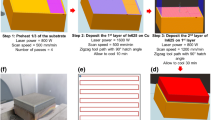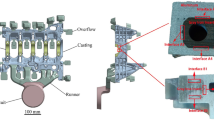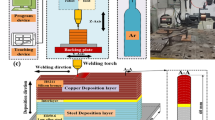Abstract
The Sn-based Babbitt and ductile iron bimetallic composites were fabricated by liquid–solid compound casting process. The Sn-based Babbitt alloy was melted in an electrical furnace and then poured into a mould containing ductile iron solid substrate. Different pre-treatment conditions for ductile iron surface using grinding, polishing and normalizing heat treatment were applied before tinning process for the aim of surface graphite decarburization. Such kind of approach can be considered as a promising way allowing using ductile iron as a substrate in the manufacturing of bimetallic materials. The results of the experiments show that only 40% of interfacial bonding area was achieved by the grinding and polishing (for 10 min) of ductile iron substrate, whereas, by the normalizing heat treatment of ductile iron substrate at 850 °C for 25 min (along with grinding and polishing), an increasing of the interfacial bonding area of 85% was achieved. All these variations can be attributed to the relatively higher percentage of surface graphite decarburization under controlled conditions of heat treatment and substrate preparation. The test of shear stress value of the bimetal with normalized ductile iron substrate is significantly higher (9.5 ± 0.48 MPa) than that of bimetal with grinded–polished ductile iron substrate (5.5 ± 0.28). Furthermore, Babbitt/ductile iron bimetallic specimens fabricated under these certain conditions of grinding and normalizing demonstrates a relatively higher interfacial hardness level (42 ± 2.1 HV). It can be reported that the lower value of free carbon in bimetal interface of normalized ductile iron substrate improves the interfacial bonding area and the elements diffusion and consequently, leads to increasing the microhardness.
















Similar content being viewed by others
Change history
20 August 2021
A Correction to this paper has been published: https://doi.org/10.1007/s40962-021-00675-8
References
B.S. Unlu (2009) Investigation of tribological and mechanical properties of metal bearings. Bull. Mater. Sci. 32(4): 451–457. https://www.ias.ac.in/article/fulltext/boms/032/04/0451-0457
H.R. Wu, Q.L. Bi, S.Y. Zhu, J. Yang, W.M. Liu, Friction and wear properties of babbitt alloy 16–16-2 under sea water environment. Tribol. Int. 44, 1161–1167 (2011). https://doi.org/10.1016/j.triboint.2011.05.007
A.K. Valeeva, I.S. Valeev, R.F. Fazlyakhmetov, Effect of structure of B83 babbit on its wear. J Frict. Wear. 35, 311–315 (2014). https://doi.org/10.3103/S1068366614040138
F.A. Sadykov, N.P. Barykin, I.S. Valeev, V.N. Danilenko, Influence of the structural state on mechanical behavior of tin babbit. J. Mater. Eng. Perform. 12(1), 29–36 (2003). https://doi.org/10.1361/105994903770343448
M. Ramadan, K.M. Hafez (2021) Interfacial microstructure and hardness of Sn-Based Babbitt/C93700 Cu- Pb-Sn bimetallic materials. Materials Today (In press) https://doi.org/10.1016/j.matpr.2021.01.581
X. Ji, Y. Chen, Tribological behavior of babbitt alloy rubbing against Si3N4 and steel under dry friction condition. J. Mater. Eng. Perform. 25(3), 750–755 (2016). https://doi.org/10.1007/s11665-016-1893-y
P. Diouf, A. Jones, Investigation of bond strength in centrifugal lining of babbitt on cast iron. Metall. and Mater. Trans. A 41, 603–609 (2010). https://doi.org/10.1007/s11661-009-0112-y
N. Fathy, M. Ramadan (2018) Influence of volume ratio of liquid to solid and low pouring temperature on interface structure of cast Babbitt-steel bimetal composite. In: AIP conference proceedings 1996, p 020028 https://doi.org/10.1063/1.5038707
N. Fathy, Interface microstructure investigation of babbitt-carbon steel composite using flux with glycerol and petroleum jelly additives. Eng. Technol. Appl. Sci. Res. 8(3), 3028–3031 (2018). https://doi.org/10.48084/etasr.2071
M. Ramadan, A.S. Alghamdi, T. Subhani, K.S. Abdel Halim, Fabrication and characterization of Sn-based babbitt alloy nanocomposite reinforced with Al2O3 nanoparticles/carbon steel bimetallic material. Materials (2020). https://doi.org/10.3390/ma13122759
S. Manasijević, R. Radiša, Z.Z. Brodarac et al., Al-Fin bond in aluminum piston alloy & austenitic cast iron insert. Int. J. Metalcast. 9, 27–32 (2015). https://doi.org/10.1007/BF03356037
M. Ramadan, N. Fathy, K.S. Abdel Halim, A.S. Alghamdi, New trends and advances in bi-metal casting technologies. Int. J. Adv. Appl. Sci. 6(2), 75–80 (2019). https://doi.org/10.21833/ijaas.2019.02.011
J. Gawronski, J. Szajnar, P. Wróbel, Study on theoretical bases of receiving composite alloy layers on surface of cast steel castings. J. Mater. Process. Technol. 157–158, 679–682 (2004). https://doi.org/10.1016/j.jmatprotec.2004.07.153
M. Ramadan, B. Ayadi, W. Rajhi, A.S. Alghamdi, Influence of tinning material on interfacial microstructures and mechanical properties of Al12Sn4Si1Cu/Carbon steel bimetallic castings for bearing applications. Key Eng. Mater. 835, 108–114 (2020)
A.O. Bakke, J.O. Løland, S. Jørgensen et al., Interfacial microstructure formation in Al7SiMg/Cu compound castings. Int. J. Metalcast. 15, 40–48 (2021). https://doi.org/10.1007/s40962-020-00463-w
T. Vossel, N. Wolff, B. Pustal et al., Influence of die temperature control on solidification and the casting process. Int. J. Metalcast. 14, 907–925 (2020). https://doi.org/10.1007/s40962-019-00391-4
M. Pintore, O. Starykov, T. Mittler et al., Experimental investigations on the influence of the thermal conditions during composite casting on the microstructure of Cu–Al bilayer compounds. Int. J. Metalcast. 12, 79–88 (2018). https://doi.org/10.1007/s40962-017-0140-0
R.K. Tayal, S. Kumar, V. Singh et al., Characterization and microhardness evaluation of A356/Mg joint produced by vacuum-assisted sand mold compound casting process. Int. J. Metalcast. 13, 392–406 (2019). https://doi.org/10.1007/s40962-018-0264-x
R.K. Tayal, S. Kumar, V. Singh et al., Experimental investigation and evaluation of joint strength of A356/Mg bimetallic fabricated using compound casting process. Int. J. Metalcast. 13, 686–699 (2019). https://doi.org/10.1007/s40962-018-0288-2
M. Cholewa, T. Wróbel, S. Tenerowicz, Bimetallic layer castings. J. Achiev. Mater. Manuf. Eng. 43(1), 385–391 (2010)
M. Ramadan, Interface characterization of bimetallic casting with a 304 stainless steel surface layer and a gray cast iron base. Adv. Mater. Res. 1120–1121, 993–998 (2015)
ASM Handbook (1992), V.15 Casting, ASM International
G. S. Cho, K. H. Choe, K. W. Lee, A. Ikenaga (2007) J. Mater. Sci. Technol. 23(01): 97–101. https://www.jmst.org/EN/Y2007/V23/I01/97
A. R. Ghaderi, M. Nili Ahmadabadi, H. M. Ghasemi (2003) Wear 225(1–6): 410–416 https://doi.org/10.1016/S0043-1648(03)00156-X
M. Hatate, T. Shoita, N. Takahashi, K. Shimizu, Wear 251(1–12), 885–889 (2001). https://doi.org/10.1016/S0043-1648(01)00746-3
Z. Guo, M. Liu, X. Bian, M. Liu, J. Li, An Al–7Si alloy/cast iron bimetallic composite with super-high shear strength. J. Mater. Res. Technol. 9(3), 3126–3136 (2019). https://doi.org/10.1016/j.jmrt.2017.06.014
C.M. Taylor (1993) Lubrication regimes and the internal combustion. Engine Tribology 26: 75–87 https://doi.org/10.1016/S0167-8922(08)70008-7
H. He, Z. Zhao, T. Luo, X. Lu, J. Luo, Failure analysis of journal bearing used in turboset of a power plant. Mater Des 52, 923–931 (2013). https://doi.org/10.1016/j.matdes.2013.06.027
ASM Metals Handbook, vol. 01—Properties and selection—Irons, steels and high-performance alloys (1990)
L. Morais, L.A. Ferreira, Journal bearings optimization for mass balancing systems used in internal combustion engines. Ind. Lubr. Tribol. 58(6), 295–302 (2006). https://doi.org/10.1108/0036879061069137
Y.S. Lerner, Wear resistance of ductile irons. J. Mater. Eng. Perform. 3, 403–408 (1994). https://doi.org/10.1007/BF02645338
ASM Handbook, vol. 4, Heat treatment, ASM International (1991)
M. Ramadan, T. Subhani, W. Rajhi, B. Ayadi, A. S. Al-Ghamdi (2020) A novel technique to prepare cast Al-bearing alloy/wrought steel bimetallic specimen for interfacial shear strength. Int. J. Eng. Adv. Technol. (IJEAT) https://doi.org/10.35940/ijeat.C6084.029320
M. Ramadan, A.S. Alghamdi, K.M. Hafez, T. Subhani, K.S. Abdel Halim, Development and optimization of tin/flux mixture for direct tinning and interfacial bonding in aluminum/steel bimetallic compound casting. Materials 13(24), 5642 (2020). https://doi.org/10.3390/ma13245642
J. Shin, T. Kim, K. Lim, H. Cho, G. Yang, C. Jeong, S. Yi, Effects of steel type and sand blasting pretreatment on the solid-liquid compound casting characteristics of zinc-coated steel/aluminum bimetals. J. Alloy. Compd. 778, 170–185 (2019). https://doi.org/10.1016/j.jallcom.2018.11.134
R.R. Dean, C.J. Evans, Plain bearing materials: the role of tin. Tribol. Int. 9, 101–108 (1976). https://doi.org/10.1016/0301-679X(76)90032-3
G.C. Pratt, Materials for plain bearings. Int. Metall. Rev. 18, 62–88 (1973). https://doi.org/10.1179/imtlr.1973.18.2.62
M. Goudarzi, S.A. Jahromi, A. Nazarboland, Investigation of characteristics of tin-based white metals as a bearing material. Mater. Des. 30(6), 2283–2288 (2009). https://doi.org/10.1016/j.matdes.2008.07.056
Z. Wang, X. Zhang, F. Xu, K. Qian, K. Chen, Effect of nodularity on mechanical properties and fracture of ferritic spheroidal graphite iron. China Foundry 16(6), 386–392 (2019). https://doi.org/10.1007/s41230-019-9080-z
Y. Yamaguchi, S. Kiguchi, H. Sumimoto, K. Nakamura, Effect of graphite morphology on decarburized cast iron. Int. J. Cast Met. Res. 16(1–3), 137–142 (2003). https://doi.org/10.1080/13640461.2003.11819572
P.H. Dionisio, B.A. de Barros Jr, I.J. Baumvol, Intermetallic phases formed during tin implantation into iron and steels. J. Appl. Phys. 55(12), 4219–4224 (1984). https://doi.org/10.1063/1.333022
G. Rzepka, J. Nawrocki, J. Sieniawski, Decarbonizing of ductile cast iron surface for usage in two-layered casting. Adv. Manuf. Sci. Technol. 44(4), 113–120 (2020). https://doi.org/10.2478/amst-2019-0018AMST
Acknowledgements
This research has been funded by Scientific Research Deanship at University of Ha’il—Saudi Arabia through project number RG-20074
Author information
Authors and Affiliations
Corresponding author
Additional information
Publisher's Note
Springer Nature remains neutral with regard to jurisdictional claims in published maps and institutional affiliations.
The original online version of this article was revised: K. M. Hafez's affiliation was corrected.
Rights and permissions
About this article
Cite this article
Ramadan, M., Hafez, K.M., Alghamdi, A.S. et al. Novel Approach for Using Ductile Iron as Substrate in Bimetallic Materials for Higher Interfacial Bonding Bearings. Inter Metalcast 16, 987–1000 (2022). https://doi.org/10.1007/s40962-021-00653-0
Received:
Accepted:
Published:
Issue Date:
DOI: https://doi.org/10.1007/s40962-021-00653-0




